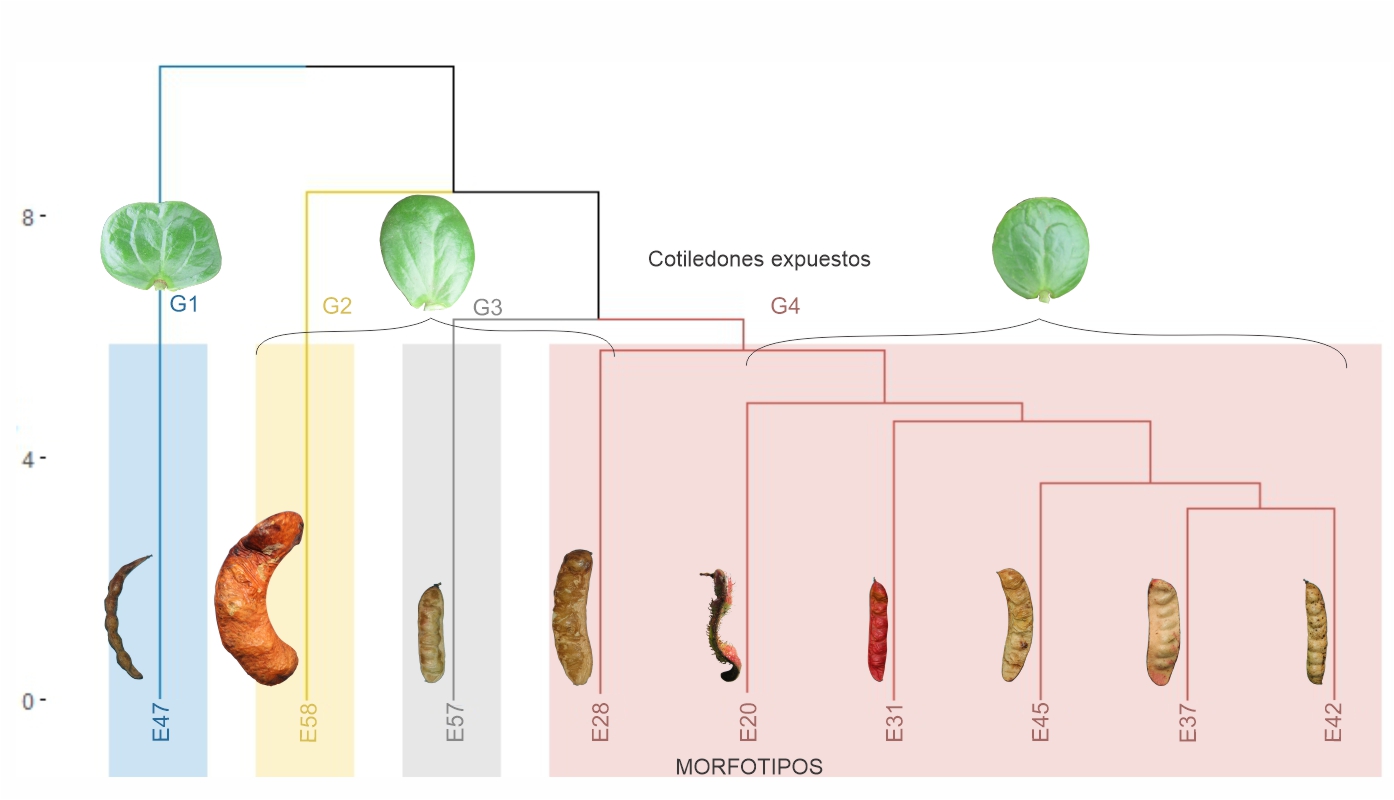Seedling descriptors and new grouping of the Tara spinosa germoplasm from the Cajamarca region, Peru
DOI:
https://doi.org/10.30972/bon.3317344Keywords:
Caesalpinia spinosa, descriptores, plántulas, “tara”, “taya”Abstract
Tara spinosa (Molina) Britton & Rose (Fabaceae), known as “tara” or “taya”, probably native to Peru, grows from sea level to 3000 m a.s.l., and is important for the tannins and gum contained in its pods and seeds, respectively. The objectives were to define and validate morphological seedling descriptors and to characterize “tara” germplasm from the Cajamarca region (58 entries from nine provinces) by integrating fruit, seed and seedling descriptors. Seven highly discriminating seedling descriptors were identified, with cotyledon descriptors being the most important. Characterization of “tara” from Cajamarca germplasm with 18 integrated descriptors (six fruit, five seed and seven seedling) allowed a new clustering, in seven groups, indicating close variability (86% duplicates).
Downloads
References
Abozeid, A., Turki, Z., El-Shayeb, F. & Tang, Z. (2017). Embryo and seedling morphology of some Trigonella L. species (Fabaceae) and their taxonomic importance. Flora 230: 57-65. https://doi.org/10.1016/j.flora.2017.02.026
Balaguer, L., Arroyo-García, R., Jiménez, P., Jiménez, M. D., Villegas, L., Cordero, I., de Casas, R. R., Fernández-Delgado, R., Ron, M. E., Manrique, E., Vargas, P., Cano, E., Pueyo, J. J. & Aronson, J. (2011). Forest restoration in a fog oasis: Evidence indicates need for cultural awareness in constructing the reference. PLoS ONE 6(8): e23004. https://doi.org/10.1371/journal.pone.0023004
Bonilla, H., López, A., Carbajal, Y. & Siles, M. (2016). Morphometric analysis in “tara” fruits from Yauyos and Ayacucho to identify traits of agromorphological interest. Scientia Agropecuaria 7: 157-164. https://doi.org/10.17268/sci.agropecu.2016.03.01
Burghardt, A. D., Brizuela, M. M. & Palacios, R. A. (2000). Variabilidad en plántulas de algunas especies de Prosopis L. (Fabaceae): En busca se descriptores morfológicos. Multequina 9: 23-33.
Canelas, G. (2013). Validación de un descriptor de tara Caesalpinia spinosa (Molina) Kuntze de los valles interandinos de Bolivia. Tesis de pregrado Universidad Mayor de San Simón, Cochabamba, Bolivia. 71 pp.
Cervantes, E., Martín, J. J. & Saadaoui, E. (2016). Updated methods for seed shape analysis. Scientifica 5691825: 1-10. https://doi.org/10.1155/2016/5691825
Chen, R., Ran, J., Hu, W., Dong, L., Ji, M., Jia, X., Lu, J., Gong, H., Aqeel, M., Yao, S., An, L., He, J. S., Niklas, K. J. & Deng, J. (2021). Effects of biotic and abiotic factors on forest biomass fractions. National Science Review 8: nwab025. https://doi.org/10.1093/nsr/nwab025
Cordero, I., Jiménez, M. D., Delgado, J. A., Balaguer, L., Pueyo, J. J. & Rincón, A. (2021). Local adaptation optimizes photoprotection strategies in a Neotropical legume tree under drought stress. Tree Physiology 41: 1641-1657. https://doi.org/10.1093/TREEPHYS/TPAB034
Crisci, J. & López, M. (1983). Introducción a la teoría y práctica de la taxonomía numérica. Secretaría de la Organización de Estados Americanos (OEA).
Dah, D., Adoukonou, H., Nafan, D., Adjanohoun, A., Noumavo, P. A., Sina, H., Daouda, B. O. & Baba-Moussa, L. (2016). Morpho-agronomic variability of three kola trees accessions [Cola nitida (Vent.) Schott et Endl., Cola acuminata (P. Beauv.) Schott et Endl., and Garcinia kola Heckel] from Southern Benin. Genetic Resources and Crop Evolution 63: 561-579. https://doi.org/10.1007/s10722-015-0362-z
Das, N. (2014). The effect of seed sources variation and presowing treatments on the seed germination of Acacia catechu and Elaeocarpus floribundus species in Bangladesh. International Journal of Forestry Research 214: 984194. https://doi.org/http://dx.doi.org/10.1155/2014/984194
Dias de Freitas, A. D., Martins Leão, N. V., Raimunda, de Vilhena Potiguara, C., Souza Reis, A. & Venicio Sousa, D. (2014). Caracterização morfológica do fruto, semente e desenvolvimento pós-seminal de Aspidosperma spruceanum Benth. ex Mull. Arg. (Apocynaceae). Centro Científico Conhecer - Goiânia 10: 863-873.
Ferreira, R. & Barbosa, S. (2015). Caracterização morfológica de frutos, sementes, plântulas e mudas de Pau-Brasil. Revista Árvore 39: 505-512. https://doi.org/http://dx.doi.org/10.1590/0100-67622015000300011
Gagnon, E., Bruneau, A., Hughes, C. E., de Queiroz, L. & Lewis, G. P. (2016). A new generic system for the pantropical Caesalpinia group (Leguminosae). PhytoKeys 71: 1-160. https://doi.org/10.3897/phytokeys.71.9203
Gagnon, E., Lewis, G. P., Solange Sotuyo, J., Hughes, C. E. & Bruneau, A. (2013). A molecular phylogeny of Caesalpinia sensu lato: Increased sampling reveals new insights and more genera than expected. South African Journal of Botany 89: 111-127. https://doi.org/10.1016/J.SAJB.2013.07.027
Gbèdomèdji, A., Fandy, H., Adomou, A. C. & Yédomonhan, H. (2022). Influence of morphological characteristics of fruits and provenances on seedling emergence and early growth in Detarium microcarpum Guill. & Perr. and Detarium senegalense J. F. Gmel. (Fabaceae) in Benin. Heliyon 8: e10945. https://doi.org/10.1016/j.heliyon.2022.e10945
Guerrero, R., Lombardi, I., Gonzales, H., Serrudo, C. & Calderón, A. (2016). Determinación de la viabilidad de semilla de Caesalpinia spinosa (Molina) Kuntze y su correlación con el contenido de goma y tanino. Revista Forestal del Perú 31: 69-80.
Hartmann, L. D. S. & Rodrigues, R. S. (2015). Morfologia de plântulas de Ormosia smithii Rudd e sua relevância sistemática em Ormosia (Leguminosae, Papilionoideae). Boletim Do Museu Paraense Emílio Goeldi-Ciências Naturais 10: 279-288. https://doi.org/10.46357/bcnaturais.v10i2.487
Hounkpèvi, A., Azihou, A. F., Kouassi, É. K., Porembski, S. & Glèlè Kakaï, R. (2016). Climate-induced morphological variation of black plum (Vitex doniana Sw.) in Benin, West Africa. Genetic Resources and Crop Evolution 63: 1073-1084. https://doi.org/10.1007/s10722-016-0409-9
IPNI. (2023). International Plant Names Index. Published on the Internet http://www.ipni.org, The Royal Botanic Gardens, Kew, Harvard University Herbaria & Libraries and Australian National Herbarium (Consulta 03/2023).
Joseau, M. J., Verga, A. R., Pilar Díaz, M. del & Julio, N. B. (2013). Morphological diversity of populations of the genus “Prosopis” in the semiarid Chaco of Northern Cordoba and Southern Santiago Del Estero. American Journal of Plant Sciences 04: 2092-2111. https://doi.org/10.4236/ajps.2013.411261
Kassambara, A. (2019). Practical guide to principal component methods in R: Multivariate analysis (Edition 1). Statistical tools for high-throughput data analysis.
Kassambara, A. & Mundt, F. (2020). Factoextra: Extract and visualize the results of multivariate data analyses. In CRAN- R Package.
Leakey, R. R. B. (2019). From ethnobotany to mainstream agriculture: socially modified Cinderella species capturing ‘trade-ons’ for ‘land maxing’. Planta 250: 949-970. https://doi.org/10.1007/s00425-019-03128-z
Moreno, S. O., Upton, J. L., Monsalvo, V. S. & Casas, M. J. (2022). Repetibilidad de características útiles como descriptores morfológicos en clones de Cedrela odorata L. Revista Mexicana de Ciencias Forestales 13: 4-32.
Murga-Orrillo, H., Abanto-Rodriguez, C., Fernandes, L., Dionisio, S., Chu-Koo, F. W., Schwartz, G., Bustamante, E. N., Stewart, P. M., Santos, R., Amorim, S., Vourlitis, G. L., Lobo, F. D. A. & Bardales-lozano, R. M. (2023). Tara (Caesalpinia spinosa) in natural and agroforestry systems under an altitudinal gradient in the peruvian Andes : responses to soil and climate variation. Agronomy 13: 1-17. https://doi.org/https://doi.org/10.3390/agronomy13020282
Narváez, A., Calvo, A. & Troya, A. M. (2010). Las poblaciones naturales de la tara (Caesalpinia spinosa) en el Ecuador: una aproximación al conocimiento de la diversidad genética y el contenido de taninos por medio de estudios moleculares y bioquímicos. En Barrionuevo M. de los A. & G. Medina (eds.), Serie Investigación y Sistematización No. 7. Programa Regional ECOBONA-INTERCOOPERATION, Laboratorio de Biotecnología Vegetal Escuela de Ciencias Biológicas Pontificia Universidad Católica del Ecuador PUCE. Quito.
Neri, J., Collazos, R., Oliva, M., Huamán Huaman, E. & Vásquez García, J. (2018). Aplicación de la escarificación física y mecánica en la emergencia y crecimiento de semillas de tara (Caesalpinia espinosa). Revista de Investigación de Agroproducción Sustentable 2: 45. https://doi.org/10.25127/aps.20182.392
Núñez, J., Quiala, E., de Feria, M., Mestanza, S., Gómez Kosky, R., Cuadrado, F., & Leiva Mora, M. (2017). Establecimiento de un banco clonal de Caesalpinia spinosa (Mol.) O. Kuntz mediante selección de árboles plus e injerto. Biotecnología Vegetal 17: 41-49.
Núñez, J., Quiala, E., Posada, L., Mestanza, S., Sarmiento, L., Daniels, D., Arroyo, C. R., Naranjo, B., Vizuete, K., Noceda, C. & Gómez-Kosky, R. (2021). Morphological and physiological responses of tara (Caesalpinia spinosa (Mol.) O. Kuntz) microshoots to ventilation and sucrose treatments. In Vitro Cellular & Developmental Biology 57: 1-14. https://doi.org/10.1007/s11627-020-10104-w
Palacio, F. X., Apodaca, M. J. & Crisci, J. V. (2020). Análisis multivariado para datos biológicos: Teoría y su aplicación utilizando el lenguaje R. 1° Ed. Buenos Aires, Argentina.
Pfennig, D. W. (2021). Phenotypic plasticity & evolution: Causes, consequences, controversies (First edit). CRC Press. Taylor & Francis Group, LLC. https://doi.org/10.1201/9780429343001
Ramírez, B., & Goyes R. (2004). Generalidades, morfología y anatomía de plantas superiores (1° Edición). Editorial Universidad del Cauca, Colombia.
Salako, V. K., Kégbé, A. M., Chadaré, F. J., Kafoutchoni, K. M., Amagnidé, A., Gbedomon, R. C., Assogbadjo, A. E., Agbangla, C. & Glèlè Kakaï, R. (2019). Potential for domestication of Borassus aethiopum Mart., a wild multipurpose palm species in Sub-Saharan Africa. Genetic Resources and Crop Evolution 66: 1129-1144. https://doi.org/10.1007/s10722-019-00777-7
Sangay, S. & Duponnois, R. (2018). Ecological characteristics of Tara (Caesalpinia spinosa), a multipurpose legume tree of high ecological and commercial value. Agricultural Research Updates 22: 189-208.
Schütz, R., da Silva Hartmann, L. & Silva Flores, A. (2019). Seedling morphology of some Brazilian taxa of Aeschynomene (Leguminosae) and its systematic relevance. Flora 255: 69-79. https://doi.org/10.1016/j.flora.2019.04.002
Tamošaitis, S., Jurkšienė, G., Petrokas, R., Buchovska, J., Kavaliauskienė, I., Danusevičius, D. & Baliuckas, V. (2021). Dissecting taxonomic variants within Ulmus spp. Complex in natural forests with the aid of microsatellite and morphometric markers. Forests 12: 1-19. https://doi.org/10.3390/f12060653
The Royal Horticultural Society (RHS). (1995). In Colour Chart. London.
Tillich, H. J. (2007). Seedling diversity and the homologies of seedling organs in the order Poales (monocotyledons). Annals of Botany 100: 1413-1429. https://doi.org/10.1093/aob/mcm238
Vega, C., Aguilar, D., Bessega, C., Teich, I., Acosta, M. C., Cosacov, A., Ewens, M., Vilardi, J., Sérsic, A. N. & Verga, A. (2021). Genetic variation patterns of “Algarrobos” from the “Great American Chaco” (Prosopis alba, P. nigra, P. hassleri, P. fiebrigii, P. ruscifolia, P. chilensis and P. flexuosa). En Pastorino, M. J. & P. Marchelli (eds.), Low Intensity Breeding of Native Forest Trees in Argentina, pp. 245-269. Springer, Cham. https://doi.org/10.1007/978-3-030-56462-9_9
Vega, C. D., Teich, I., Acosta, M. C., Lauenstein, D. L., Verga, A. R. & Cosacov, A. (2020). Morphological and molecular characterization of a hybrid zone between Prosopis alba and P. nigra in the Chaco region of northwestern Argentina. Silvae Genetica 69: 44-54. https://doi.org/10.2478/sg-2020-0007
Villena, J. J., Muñoz Chávarry, P., Seminario, J. F. & Martínez Sovero, G. (2022). Caracteres morfométricos como indicadores de calidad de sitio de Tara spinosa (Leguminosae, Caesalpinioideae) en Cajamarca, Perú. Lilloa 59: 33-50. https://doi.org/https://doi.org/10.30550/j.lil/2022.59.1/2022.04.01
Villena, J. J. & Seminario, J. (2021). Origen y domesticación de Tara spinosa (Leguminosae, Caesalpinioideae). Lilloa 58: 131-159. https://doi.org/https://doi.org/10.30550/j.lil/2021.58.2/2021.11.14
Villena, J., Seminario, J. F. & Valderrama, M. (2019). Variabilidad morfológica de la tara Caesalpinia spinosa (Molina) Kuntze (Fabaceae), en poblaciones naturales de Cajamarca: descriptores de fruto y semilla. Arnaldoa 26: 555-574. https://doi.org/10.22497/arnaldoa.262.26203
Zhang, H., Li, J., Zhang, J. & Dong, Y. (2024). Speeding up k-means clustering in high dimensions by pruning unnecessary distance computations. Knowledge-Based Systems 284, article 111262. https://doi.org/10.1016/J.KNOSYS.2023.111262
Zhu, Y., Chen, C., Guo, Y., Fu, S. & Chen, H. Y. H. (2020). Forest ecology and management linking leaf-level morphological and physiological plasticity to seedling survival and growth of introduced Canadian sugar maple to elevated precipitation under warming. Forest Ecology and Management 457: 117758. https://doi.org/10.1016/j.foreco.2019.117758

Downloads
Published
Versions
- 2024-02-22 (3)
- 2024-02-09 (2)
- 2024-02-09 (1)
How to Cite
Issue
Section
License
Copyright (c) 2024 Bonplandia

This work is licensed under a Creative Commons Attribution 4.0 International License.
Declaration of Adhesion to Open Access
- All contents of Bonplandia journal are available online, open to all and for free, before they are printed.
Copyright Notice
- Bonplandia magazine allows authors to retain their copyright without restrictions.
- The journal is under a Creative Commons Attribution 4.0 International license.














.jpg)


